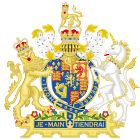|
Calico Acts
The Calico Acts (1700, 1721) banned the import of most cotton textiles into England, followed by the restriction of sale of most cotton textiles. It was a form of economic protectionism, largely in response to India (particularly Bengal), which dominated world cotton textile markets at the time. The acts were a precursor to the Industrial Revolution, when Britain eventually surpassed India as the world's leading textile manufacturer in the 19th century.[1] ContextThe English East India Company introduced Britain to cheap calico and chintz cloth after the restoration of the monarchy in the 1660s. Initially imported as a novelty side line, from its spice trading posts in Asia, the cheap colourful cloth proved popular and overtook the EIC's spice trade by value in the late 17th century. The EIC embraced the demand, particularly for calico, by expanding its factories in Asia and producing and importing cloth in bulk, creating competition for domestic woollen and linen textile producers. The impacted weavers, spinners, dyers, shepherds and farmers objected, with Parliament petitioned, the EIC offices stormed by a mob, the fashion conscious assaulted for wearing imported cloth, making the calico question one of the major issues of national politics between the 1680s and the 1730s. Parliament began to see a decline in domestic textile sales, and an increase in imported textiles from places like China and India. Seeing the East India Company and their textile importation as a threat to domestic textile businesses, Parliament passed the Encouragement of Manufactures Act 1698 (11 Will. 3. c. 10), blocking the importation of cotton cloth. As there was no punishment for continuing to sell cotton cloth, smuggling of the popular material became commonplace. So, dissatisfied with the outcome of the first act, in 1721 Parliament passed a stricter addition, the Woollen, etc., Manufactures Act 1720 (7 Geo. 1. St. 1. c. 7). This time they prohibiting the sale of most cottons, imported and domestic (exempting only thread Fustian and raw cotton). The exemption of raw cotton from the prohibition initially saw 2,000 bales of raw cotton imported annually, to become the basis of a new indigenous industry, initially producing Fustian for the domestic market, though more importantly triggering the development of a series of mechanised spinning and weaving technologies, to process the material. This mechanised production was concentrated in new cotton mills, which slowly expanded till by the beginning of the 1770s seven thousand bales of cotton were imported annually, and pressure was put on Parliament, by the new mill owners, to remove the prohibition on the production and sale of pure cotton cloth, as they wished to compete with the EIC for the British cotton market. The acts were repealed in 1774, triggering a wave of investment in mill based cotton spinning and production, doubling the demand for raw cotton within a couple of years, and doubling it again every decade, till the 1840s.[2] According to the Indian historian Prasannan Parthasarathi, mechanization and the factory system allowed the British cotton producers "to out-produce not just the quantity, but the quality of Indian textiles", while the textile work in England was paid with a higher salary than that paid in India.[3] Acts
References
|
||||||||||||||||||||||||||||||||||||||||||

